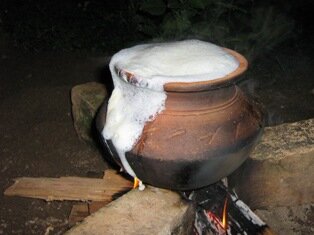Ponggal is a holy festival which is celebrated for three consecutive days. I was told that it is the only Indian festival that celebrates on the solar calendar and it is on the fourteenth of January every year. For other Hindus festivals it follows the lunar calendar.
Most homes would decorate the house with sugar cane, mango leaves and turmeric leaves to celebrate the Ponggal festival.
Sugar cane are placed at the entrance of the homes as a symbol for everything sweet and good happenings for the family.
Usually in every Indian house, the entrance door is lined with mango leaves, so this is the time to change to new mango leaves.
The significance of the turmeric leave is that it wards off all bad omens and the leaves are used with turmeric water to clean or bless the house with it. They also use it to tie round the earthen clay pot.

It is a thanksgiving festival celebrated by Tamils of Hindu faith. It is celebrated during the harvesting month to thank God and to offer gratitude to nature for a good harvest.
For Indians in India, it is very grand festive times for the farmers and livestock breeders.
It is the time to offer gratitude for the main essentials needs of living things, that is water, land, air. And not forgetting the graciousness of the sun, they offer the day's prayer to Surian, the Sun god.
The first day is celebrated for the harvested crops and share with friends and relatives. The main feature of this festival is the boiling of milk in a clay pot.
When the milk overflows, the family members gathered round the pot will shout, 'Ponggale oh Ponggale'. Then add rice to it. In Tamil means boiling and overflowing.
The second day known as Mattu Ponggal, cows are worshipped and given the offerings. This is the time when villages decorate the cows and also the elders seek God's blessing for their children.
The cows are given a bath, their horns are painted and they are decorated with garlands.
And on the third day known as Kanni Ponggal, young ladies prays for a good life and a dashing great husband. The young unmarried ladies wearing new clothes, gold and silver ornaments will have special prayers for their future marriage.
Then we watch and sooth the fire to burn to boil the milk. As the milk overflows, we shrieks and shout 'pongale oh pongale'.
Bearing in mind that once the milk spills, it means prosperity and if the milk spills as the sun rises, it is a good sign for the family.
We then scoop half of the boiled milk for offering to his departed parents and ancestors and left some for us to drink. We then took turns to spoon a ladle of sweetened rice for cooking.
As the sweetened rice is about to cook, we added a spoonful of ghee and took it off the fire for 10 mins.
Once the sweetened rice is ready, we made an offering to our ancestors. Whereas for the remainder, we called our neighbors over and shared our good tradition with them.
Ancestors offering can be prepared in the manner of what they loved to eat when they were alive. With this in mind, my husband bought all kinds of sweet goodies and offered during the prayers.
- Ingredients to cook sweetened rice
- Serves four persons
- 150 Gms of prepared rice
- 45 oz of fresh or reconstituted milk
- 100 Gms ghee
- Half teaspoon of cinnamon powder
- Ingredients needed for sweetened rice
- 75gms of rice
- Chopped Toasted Almonds
- Chopped Toasted Cashew nuts
- 25 Gms of brown sugar
- 25 Gms of Raisins
I think it is a very sweet rice meal. So those who has to be careful with sugar intake, be caution.
Back to My Island Penang Home Page























